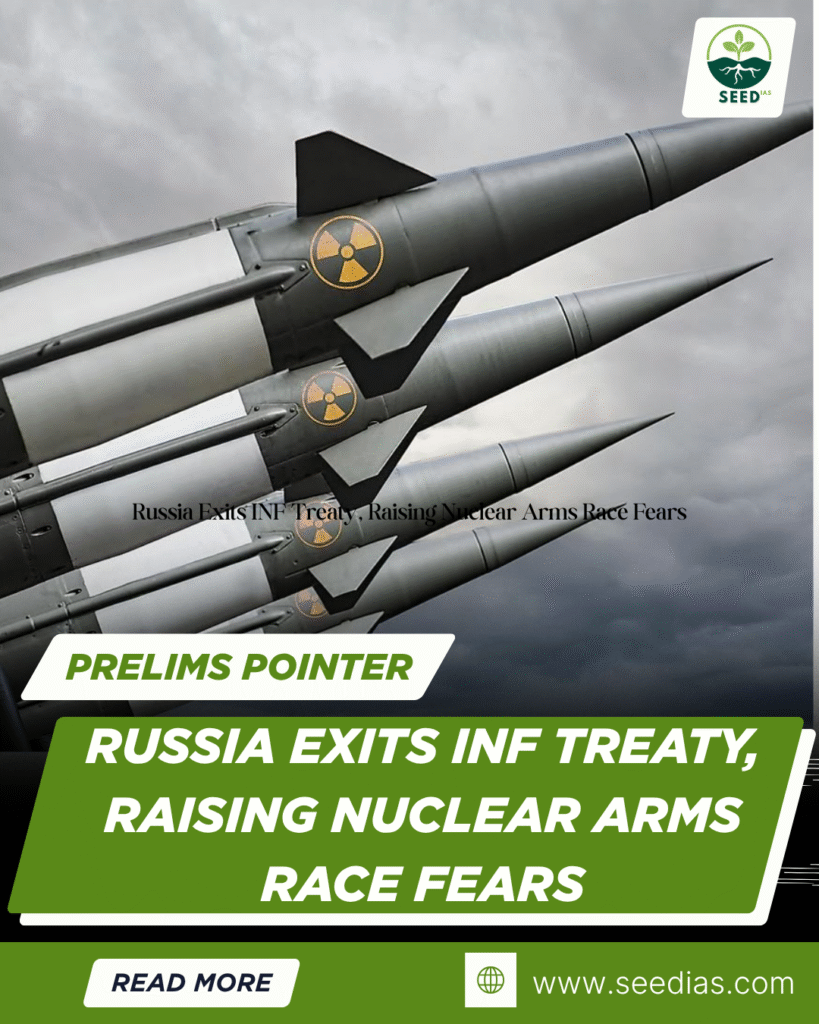Why in NEWS
Russia has formally withdrawn from the 1987 Intermediate-Range Nuclear Forces (INF) Treaty, following the US exit in 2019. The move intensifies global fears over a renewed arms race and weakens nuclear disarmament efforts.
Key Concepts/Terms
| Term | Explanation |
|---|---|
| INF Treaty (1987) | A Cold War-era arms control agreement between the US and USSR banning ground-launched missiles with ranges between 500–5,500 km. |
| Typhon Missile System | A new US missile platform that Russia sees as a threat to its national security. |
| Talisman Sabre Exercises | Joint military drills between the US and Australia, cited by Russia as aggressive posturing. |
| Arms Control | Measures to control the development, testing, production, and deployment of weapons, especially nuclear ones. |
News Simplified for UPSC
- The INF Treaty banned intermediate-range ground-launched missiles (500–5,500 km) to reduce Cold War tensions.
- The US withdrew in 2019, accusing Russia of violating the treaty by developing prohibited missile systems.
- Now, Russia has also exited, citing:
- The deployment of US Typhon missile systems in the Philippines.
- US-led missile drills in Australia under “Talisman Sabre.”
- The treaty is now effectively defunct, removing a key global arms control safeguard.
Major Arms Control Treaties Overview
| Treaty | Year | Objective | India’s Position |
|---|---|---|---|
| NPT (Non-Proliferation Treaty) | 1970 | Prevent the spread of nuclear weapons; promote peaceful nuclear technology | Not a signatory |
| CTBT (Comprehensive Nuclear-Test-Ban Treaty) | 1996 | Ban all nuclear tests and explosions | Not signed |
| New START | 2010 | Limit deployed strategic nuclear warheads and delivery systems (US & Russia) | Not applicable to India |
Global Implications
| Concern | Impact |
|---|---|
| Renewed Arms Race | Countries may invest in new missile systems to match rivals. |
| Erosion of Trust | Undermines decades of disarmament diplomacy. |
| Weakening of Non-Proliferation Norms | May embolden other countries to abandon treaties. |
| Regional Instability | Raises tensions in the Indo-Pacific and Eastern Europe. |
In a nutshell
INF Treaty Dead = New Missiles + New Tensions + Less Trust
Mnemonic Code: “INF-NOT SAFE” → INF Treaty – Nukes – Security At Further Exposure
Prelims Questions
- Which of the following was banned under the INF Treaty?
A. All submarine-launched missiles
B. Air-to-surface cruise missiles
C. Ground-launched missiles with range 500–5,500 km
D. Intercontinental Ballistic Missiles (ICBMs) - Which of the following statements is correct?
A. India is a founding member of the NPT
B. CTBT allows limited underground nuclear testing
C. New START limits only non-nuclear weapons
D. INF Treaty was signed by the US and USSR in 1987 - The Typhon missile system was recently in news due to
A. US deployment in Eastern Europe
B. Russia’s offer to NATO
C. Its deployment in the Philippines, seen as a provocation by Russia
D. India’s testing of a variant under Agni project
Prelims Answers with Explanation
| Q | Answer | Explanation |
|---|---|---|
| 1 | C | The INF Treaty specifically banned ground-launched missiles with ranges between 500–5,500 km. |
| 2 | D | The INF Treaty was signed by the US and the USSR in 1987. India is not part of NPT or CTBT. |
| 3 | C | Russia cited the US deployment of the Typhon system in the Philippines as a key reason for exiting the treaty. |
















